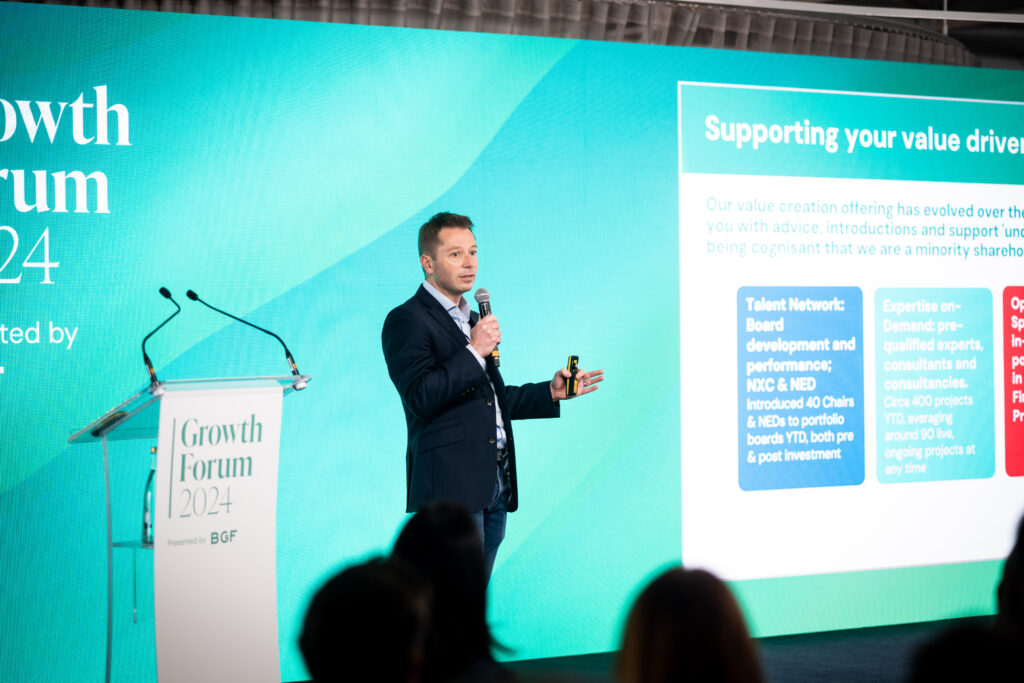Scaling your SaaS sales function: in conversation with Sales Blueprint
Developing an effective sales function is a key part of the scaleup journey for SaaS companies. Learn more in this Q&A.
Transitioning from founder-led sales to a scalable commercial sales function is a key part of the scaleup journey.
This was the focus of a recent networking dinner that we hosted for founders and CEOs in the enterprise software space. Following the event, BGF investor Chris Morgan sat down with guest speaker Graeme Hall, Founder of Sales Blueprint, to get his take on the matter—and any advice for software-as-a-service (SaaS) companies looking to scale their sales functions.
Read our Q&A with Graeme below to learn about the importance of codifying your value proposition and how to shift away from founder-led sales, plus his tips for international growth.
Graeme Hall, Sales Blueprint
Graeme started Sales Blueprint in 2000, to share his sales leadership experience and knowledge with other businesses. Sales Blueprint is now a leading B2B sales and marketing consultancy, trusted by over 50% of the UK’s mid-market private equity firms. It has a strong track record of supporting growing companies across a range of sectors, typically increasing sales by around 25% in the first year. BGF works closely with Sales Blueprint, as part of the broader value creation support that we offer our portfolio.
Chris Morgan, BGF
Chris is an investor in BGF’s London team and leads our tech investment initiative out of London and the South East. He has completed 10 investments across a range of sectors since joining and sits on the Board of four BGF portfolio companies. Chris worked closely with Sales Blueprint following our recent investment into specialist training provider Alpha Development.
The lowdown on SaaS sales
Chris: Thank you for taking the time to talk to us today, Graeme. One of the key challenges facing growth SaaS businesses is in scaling and professionalising their sales function. Where do you like to begin your conversations with management teams to support them on this journey?
Graeme: We start by asking businesses about their go-to-market (GTM) strategy. When separating good sales functions from great ones, some questions are particularly telling:
- How clearly can they articulate their value proposition?
- How well do they understand the intangible benefits and underlying use cases of their product?
- Do they have a clearly defined ideal customer profile?
We’ve worked with around 450 B2B businesses so far. Whilst there’s no one-size-fits-all approach to enterprise sales, the most successful and most profitable of these businesses all have a solid GTM strategy in place—the ‘secret sauce’ to making people buy your product.
Chris: The value proposition point is interesting. I’ve found that, particularly in technology, there can be a disconnect between the clever tech that’s been built and the underlying reason customers choose to buy a product. From your experience, what are the most common mistakes businesses make when constructing their value propositions?
Graeme: You’re right that the value proposition for customers often isn’t aligned with the value proposition for management teams. My advice to businesses would be to do your research, instead of making assumptions.
Start with your customers. Businesses tend to be much better at asking why they lose and often forget to ask why they win! You can keep this fairly short. Just ask them: Why us? Why now? What factors did you consider? It’s easy to convince people to answer surveys if you position them right; emphasise how the process will benefit you both, as their feedback will inform your product roadmap and improve their overall customer experience.
Of course, you should also speak to the leads that you lost, as it’s just as important to know why people didn’t buy as why they did.
The other mistake that businesses make is treating value propositions as if they’re static. You should be speaking to your customers and testing any changes that come out of this process regularly.
And you should be able to write down your value proposition on one side of A4, nothing more.
Chris: How should a business go about codifying their ideal customer profile (ICP)? As with the value proposition, it’s often something that can get lost while hunting for any and all revenue sources in those early years.
Graeme: For clients that aren’t able to define their ICP themselves, we carry out workshops—it’s just about asking founders the right questions. A helpful analogy is a car park of 50 cars, where only one fits your ICP. How would you decide which car to go up to first, to avoid wasting time inspecting the other 49?
Once you think you have your ICP, test it against your current customers (how would they score?) and adjust as needed.
Chris: Aside from the value proposition and ICP, are there any other pieces of advice you would have for founders as they transition to a more professionalised sales function?
Graeme: When you’re looking to scale your sales team, it’s important to codify your selling methods alongside the value proposition and ICP.
This is particularly true for founder-led businesses, as founders often sell a product based on their own lived experiences. By capturing these war stories and turning them into case studies, you create a narrative that can be repeated again and again. From there, you can start to develop a playbook for your sales team, so that you can take a step back (and eventually exit, if that’s your goal).
Chris: One of the other challenges of moving away from founder-led sales is measuring both success and efficiency, and understanding what good looks like—particularly in enterprise sales, where sales cycles can be that much longer. I like the Sales Blueprint approach here. Can you walk me through your process for assessing sales team capacity and actual resource requirements?
Graeme: It’s pretty simple, but you’d be surprised how many companies get it wrong… Often a business will hire more salespeople before checking if their current team is working at optimal efficiency (which is almost never the case).
Working out your sales capacity and developing genuine KPIs for the team (as opposed to blanket target metrics that have no roots in what’s actually required to deliver revenues) is simply a matter of:
- Understanding the activities required at each stage in the sales process
- Establishing the conversion ratios between each stage
- Identifying the quantity of key inputs required to deliver the number of deals you need
If you then compare the time associated with carrying out this level of activity and the time available from each person, you can establish the maximum revenue capacity available from each person, and the cadence they need to work at to deliver it. Often, this revenue figure is significantly higher than what any of them have achieved before!
Chris: What approach should founders take when hiring a Head of Sales? It’s such an important role for scaling businesses and yet it can be one of the hardest to recruit for.
Graeme: It can be tricky in sales to assess the quality of candidates, given that salespeople are (by their nature) great at selling! So it’s important to ask the right questions, like:
- Why do people buy from you?
- What’s your process for identifying good vs average prospects?
- What does your best salesperson do that you wish the rest of your team did too?
- Walk me through your sales process/numbers
- When did you last fire a salesperson? (There’s a sweet spot here—unwillingness to let people go results in underperformance, but being too hasty leads to inefficiencies.)
Chris: The final area I’m keen to discuss is international growth. Expansion into the US, in particular, is a key focus area for many of our investee businesses, given the enormous market size and attractive growth dynamics. But in our experience, growing international sales teams can be a good way to spend a lot of money very quickly, with little to show for it… Do you have any tips for businesses looking to expand internationally?
Graeme: When it comes to scaling your team anywhere, it’s important to make sure you have a rigorous recruitment process in place that tests the skills and competencies you need. Case study exercises are crucial for this—tasks that are less tell and more show.
In terms of international growth, it may be useful to base an existing employee out there to help build out the team and set standards. Otherwise, you risk your new team feeling or acting like a separate entity to the rest of the business, particularly if you’re expanding into a country where the sales culture is very different, like the US.
Lastly, going back to codifying your ICP and value proposition, you should also make sure your buying messages are consistent between teams and territories.





